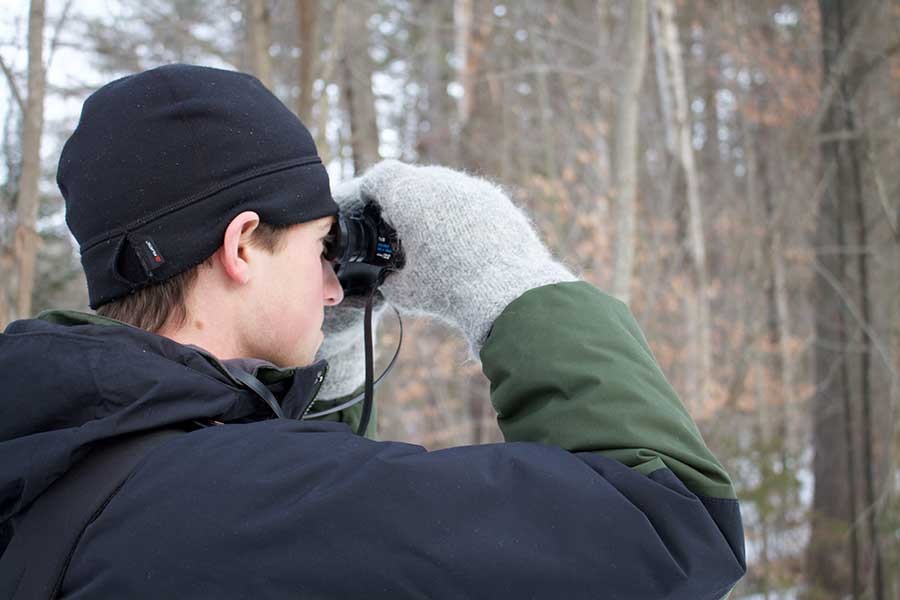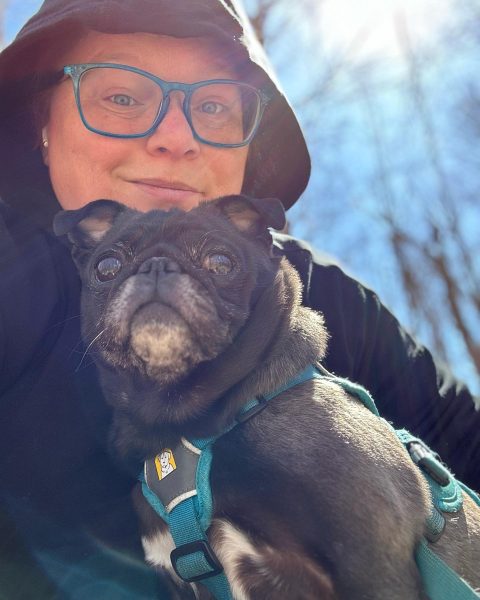The Bird Nerd of Johnson
Walking on top of crunchy white snow with trees overhead and chickadees singing, Steve Lamonde catches a glimpse of a gold-tinted bird in the distance. “Oh my God, that is definitely a Gold Crested Kinglet,” says Lamonde. The moment is short but it piques Lamonde’s enthusiasm. His binoculars point at the sky as he walks closer to the sighting, hoping for the bird to reappear.
“Kinglet birds aren’t very common,” Lamonde whispers to explain his excitement. He spots it again, and with silence and concentration he focuses his binoculars on a tree where a chubby Golden Crown Kinglet wobbles on a thin branch. “I’ve only seen those twice before today,” he says.
Next Lamonde spots a Brown Creeper. “They’re an interesting bird,” he says. “They only creep up trees. You’ll never see them creep down.” Surrounded by at least a dozen chickadees and a white and red Breasted Nuthatch, Lamonde smiles with his clear blue eyes and beak-like nose pointed toward the sky. With each new sound he turns his head in a different direction. Lamonde, who has a slender runner’s build and is usually walking fast around campus, slows down in the woods.
Steve Lamonde, a senior at Johnson State College, is an avid bird watcher and self-proclaimed bird nerd. “You know that question people ask you: what’s your favorite super power? Mine’s to fly and it’s always been that answer,” he says.
His childhood home had less than basic cable and Lamonde spent most of his time outside, exploring and playing. He remembers birds always being in the background while playing as a child. His love for nature and the outdoors eventually led him to his bird obsession. On top of being a nature enthusiast, his late grandmother fostered his love for birds. She was always out birding and this common interest brought them together. A few years before she passed away, she gave Lamonde a dream catcher with real bird feathers hanging from the wooden circle, which still has a place in his room today.
What Lamonde really loves about birds is how different each bird and species is. The variation in size, color, shape, and function all drive Lamonde in wanting to see more. “I also really like the quirky behaviors some birds have,” he says.
The adrenaline rush that kicks in when birding is another reason why Lamonde finds the whole act of walking and spotting birds so exciting. “Say there’s been a snowy owl sighting on the news and you drive out but you never know if it’s gonna be there, so when you do see it you’re really excited,” he says.
When one enters Lamonde’s dorm room, the sound of a chirping bird motion detector goes off with the swing of the door. At the head of his bed is a classroom-sized white board where he keeps track of all his graduate school applications and connections.
Lamonde plans on going to graduate school to study birds, and more deeply wildlife science. “It might be bird migration or how the populations are distributed,” says Lamonde. “Where they live, what their features and characteristics are, or their habitat.”
His senior project is gearing him up for work in post-graduate life. He is using Geographic Information Systems (GIS) to map habitats and create a bird assessment for the state of Vermont.
“I try to incorporate birds as much as I can into my school work,” says Lamonde. As a kid, Lamonde always did his assigned research papers on his favorite bird of prey, the Peregrine Falcon. “I don’t think my teachers ever caught on that it was always my topic,” he says. Today, a poster hangs in his dorm that a cross country teammate made for his senior race, and on it is a Peregrine Falcon.
As a bird watcher, Lamonde’s skills have grown over time. “For my first years of birding I could only recognize by sight, but these past years I’ve been working on recognizing birds by sound,” he says. To improve his ear for birds Lamonde has collected several CDs of bird calls, and also uses YouTube and bird apps on his iPod. He listens to the bird songs over and over again to memorize the sound for when he’s on a birding adventure.
Lamonde’s longest birding walk lasted 13 and a half hours. During an outing at Plum Island in New York, Lamonde walked 14 miles, but at times he did stop to hang out and let the birds come to him. On every bird outing he brings his binoculars, camera, iPod, and a back-up notepad and pencil. For longer walks or beaches, he will also bring a tripod to steady his camera.
Lamonde’s bird watching has almost become a sport where he keeps track of every bird and species he sees. In 2015, he identified over 9,000 individual birds and more than 129 species. He keeps track of every outing and records everything he sees on his iPod, which he then transfers into a Microsoft Excel spreadsheet.
“I might be a little addicted to Microsoft Excel and keeping track of data,” says Lamonde. When Lamonde is not tracking his bird progress on Microsoft Excel he is keeping track of personal data, whether it be body weight, resting heart rate, calories he consumes or burns per day, and even how many hours he spends studying for certain subjects.
Lamonde sets himself to high standards, not just academically but in his bird watching hobby as well. “When I bird I make sure I bird at a high quality,” says Lamonde. “I’m not just saying, ‘oh it’s a woodpecker.’ I want to know what species of a woodpecker, what habitat, what it’s doing, what’s the weather like, and for how long did I see it.”
Even though Lamonde’s birding is impressive, he has room to grow. “The Big Year,” a movie starring Steve Martin, Jack Black, and Owen Wilson, inspired Lamonde to keep track of how many birds and species he sees every year. In the movie, the characters take a year off to see as many birds as they can around the world.
These people exist in real life too, and someday Lamonde hopes to participate in a big year and travel to see as many birds as he can. For now he just reminds himself that he is a full-time college student, and that seeing thousands of bird species is unrealistic, as the world record in one year is currently 6,000.






